So, you want to travel to Antarctica, but you are wondering when to go. The Antarctic travel season coincides with the austral summer beginning in October and running through March. Many travelers ask us “When is the best time to visit Antarctica?” or “What is the weather like in Antarctica in January?”
The best time to visit Antarctica is from mid-December through mid-February. The best month to take an Antarctic cruise is January. Of course, there is much more to it than that. The Antarctic travel season is short. Weather, wildlife, sunlight and sea conditions vary greatly between spring, summer and fall.
IN THIS POST – Best Time to Visit Antarctica:
Antarctica Seasons
Month By Month:
– Oct, Nov, Dec, Jan, Feb, Mar
Best Time for:
– Drake Passage & Cruising
– Penguins & Whales
Why Latitude Matters
Antarctica Climate Tables
What Is the Best Month in Antarctica?
More Resources
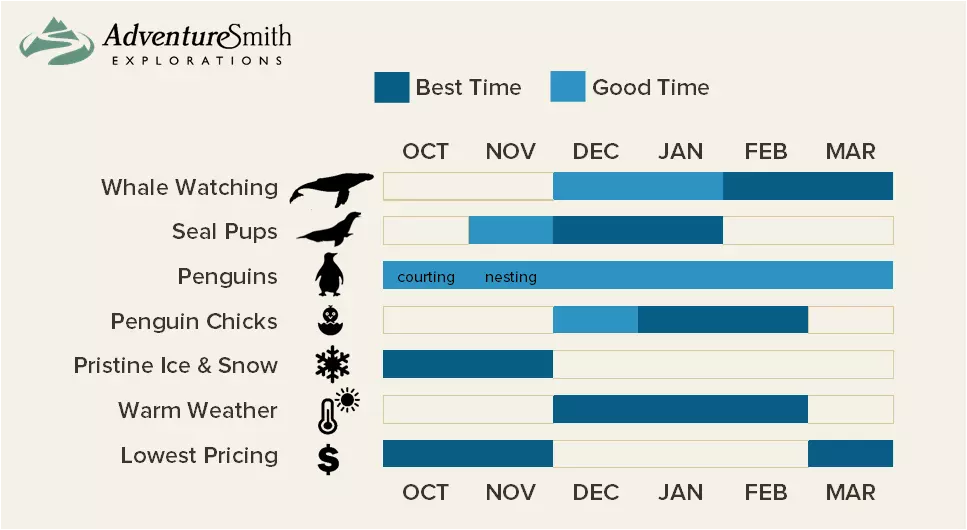
Antarctica Seasons: When to go & Why
Below we outline best seasons for Antarctica and what to expect during each Antarctic season. Remember that in the Southern hemisphere the seasons are opposite of those in North American and Europe. Winter in the northern hemisphere is summer in Antarctica.
Antarctic Spring
Spring in Antarctica begins in late October and runs through November. Antarctica in spring is characterized by cold temperatures, snow and frozen sea ice. Sea ice is at its maximum, an average of 22 million square miles, which can restrict where ships are able to go.
In the early Antarctic spring, most wildlife has not yet emerged, except for Emperor Penguins, which have overwintered on the ice. Specialty trips to view Emperor penguin colonies are sometimes offered in November.
The season to visit Antarctica begins in earnest in November. Mid to late Spring in Antarctica is characterized by the icy landscape awakening. Days are getting longer and temperatures are warming. Sea ice is common, and penguins are starting to arrive to build nests.
Antarctic spring is the best time to go to Antarctica for skiers, snowboarders and photographers set on massive icebergs and icy, white landscapes.
Antarctica Summer
Antarctica in the summer is spectacular and this is the peak of the travel season. Summer in Antarctica begins in December and runs through January. The temperature in Antarctica in the summer is surprisingly mild with highs in the 50’s F and lows in the 20’s F.
Sea ice is melting and gone by the end of Antarctic summer. This opens bays, inlets and passages south to the Arctic circle. Spring storms abate and summer in Antarctica offers a better chance of calm seas while crossing the Drake Passage.
Penguins and wildlife are most active during the Antarctic summer. Depending on latitude, (more on why latitude matters below) penguins lay their eggs in early summer and chick are born in mid-summer. Seabirds are feasting on the ocean’s bounty. Seals have come ashore to give birth to pups. Whales begin to arrive to feed on rich seas.
Antarctica Fall
Autumn in Antarctica begins in March and ends by April. Days are getting shorter, temperatures are falling and the travel season winds down by late March. Sea ice is greatly reduced from 22 million miles of sea ice in September to only 5.4 million square miles of sea ice in September. This means more bays and inlets are available for ships and the polar circle is more easily reached in the fall.
Fall in Antarctica is the best time to view whales. Ice free waters, enriched by the summer sun, provide a bounty of krill and small fish which by now have attracted large pods of migrating whales. Penguin parents have left for the open sea and chicks are ready to follow. Seal pups are also heading into the ocean and can be a target for Orca whales.
Photographers seeking spectacular sunsets love the fall Antarctic season. Visitors may also catch a glimpse of the aurora australis or southern lights during dark nights.
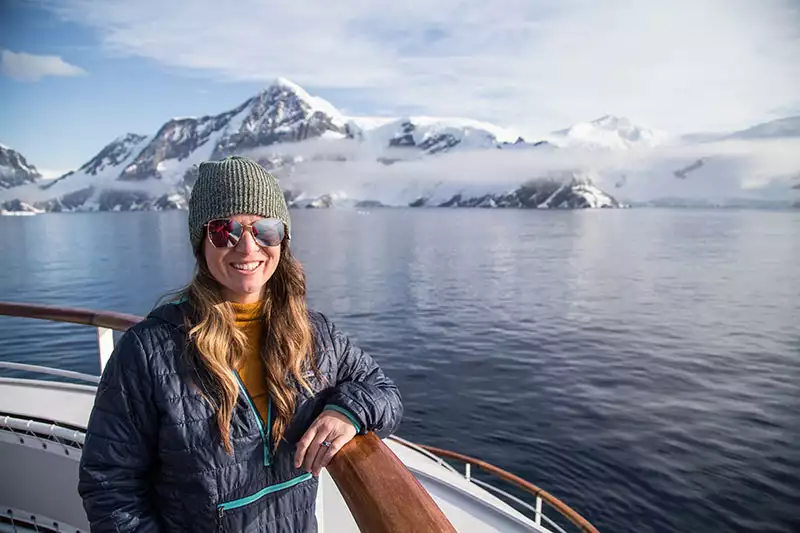
IN THE KNOW ON
WHEN TO GO
Expert insights,
delivered to your inbox.
Antarctica Weather & Wildlife by Month
What follows are detailed insights into Antarctica weather and wildlife by month for the entire travel season. Our expert compile their advice to help you determine the best time to visit Antarctica. Antarctica temperature listed below in Fahrenheit.
Antarctica In October
Be among the first to witness Antarctica as it awakens from the long winter. Antarctica in October is pristine, cold and a skier’s dream with white-capped peaks. We consider this the best time to go to Antarctica for skiers, snowboarders and photographers set on those icy, white landscapes. Specialty trips to view emperor penguins are sometimes available in October.

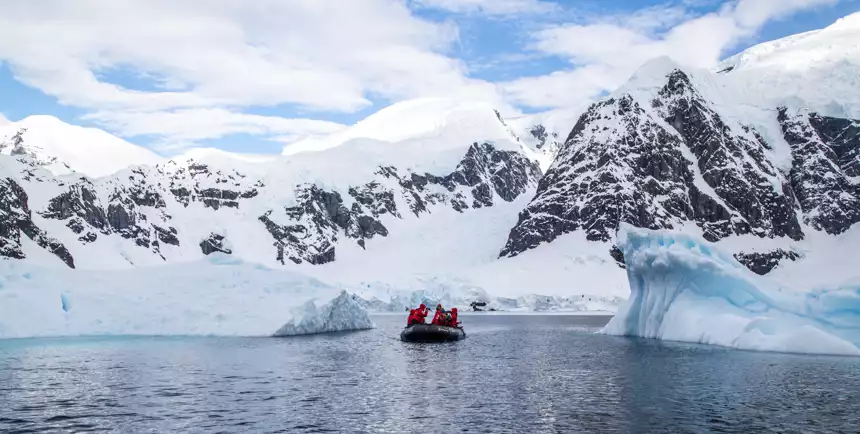


Antarctica Weather in October
- Average temperature in Antarctica in October: 22-29 degrees & 14 hours of daylight
- South Shetland Islands Temperature in October: 17-25 degrees & 15 hours of daylight
- South Georgia Island Temperature in October: 28-41 degrees & 14 hours of daylight
Benefits Visiting Antarctica in October
- Abundant sea ice, dynamic ice floes, large icebergs, all excellent for photography
- Wintering scientists look forward to visitors, make enthusiastic hosts at research stations
- Specialty trips to view Emperor penguins
- Feels like Antarctica! On cold days you’ll dress like you’re at the South Pole
Antarctica Wildlife in October
- Seabirds including skuas, albatross and petrels begin breeding activities
- Adelie, gentoo and chinstrap penguins begin the breeding cycle with courtship rituals
- Emperor penguin rookeries in the Weddell Sea may become accessible
- Crabeater seals are born
Antarctica in November
If you choose to visit Antarctica in November, you can enjoy more activities like kayaking and camping. You’ll witness nest-building behaviors from penguins. Availability starts to really ramp up with more ships making the voyage across the Drake Passage. November is the best month to go to Antarctica for active travelers. Skiing, snowboarding and snowshoeing are available only in November. Kayaking, mountaineering and camping become available as well.
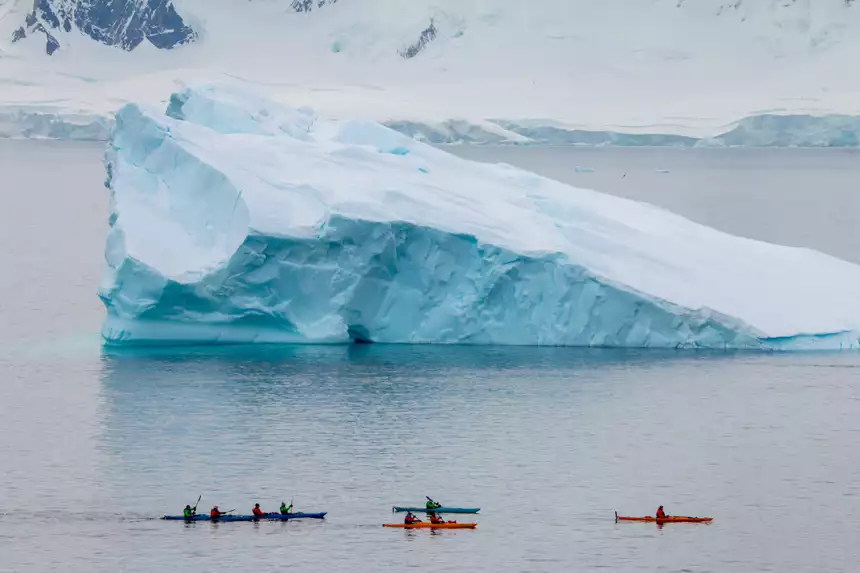


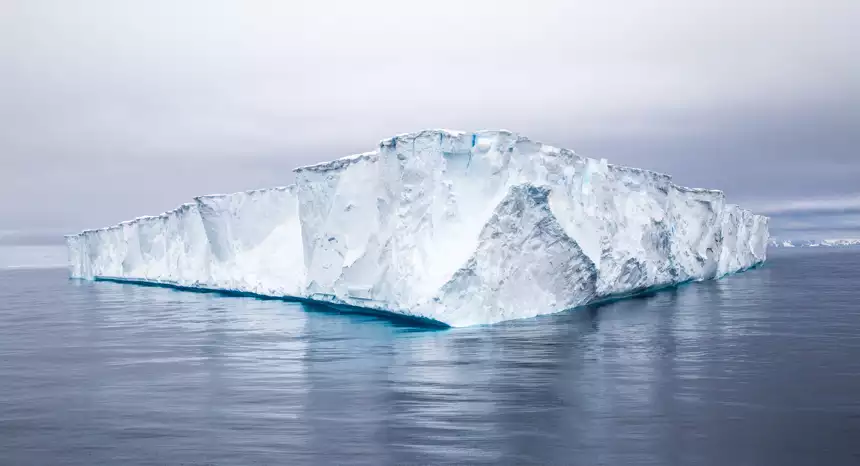
Weather in Antarctica in November
- Average temperature in Antarctica in November: 25-32 degrees & 15.5 hours of daylight
- South Shetland Islands temperature in November: 21-26 degrees & 18 hours of daylight
- South Georgia Island Temperature in November: 30-44 degrees & 16 hours of daylight
Benefits of Visiting Antarctica in November
- Pack ice begins to melt, opening up the 7 million square miles of the frozen Southern Ocean
- Longer days and lots of ice mean November is best time for landscape photographers
- Camping options begin and continue through February (select departures)
- Kayaking options begin and continue the rest of the Antarctic season (select departures)
- Early season prices are often the lowest of the year
Antarctica Wildlife in November
- Adelie, chinstrap & gentoo penguins find mate, build nests and lay eggs
- King penguins on South Georgia Island lay eggs & incubate on their feet by late November
- Albatrosses are spotted in the skies in Antarctica in November
- Spring wildflowers bloom in the Falkland Islands
- Elephant seals begin courting on South Georgia Island
- Ships are sometimes able to park on the sea ice, allowing guests to walk the frozen sea
- Fur seals mate & establish breeding territories. Aggressive mating rituals can be observed
Antarctica in December
Antarctica weather in December really heats up (well, relatively) thanks to more daylight around the solstice. The weather in Drake Passage in December also offers an increased chance for calmer seas. December is the best time for family Antarctica travel. December in Antarctica coincides with school holidays and offers great daylight and warmer temperatures with great penguin activity. December is the busiest travel month in Antarctica, so it is best to book early. Holiday cruises can sell out nearly one year in advance.
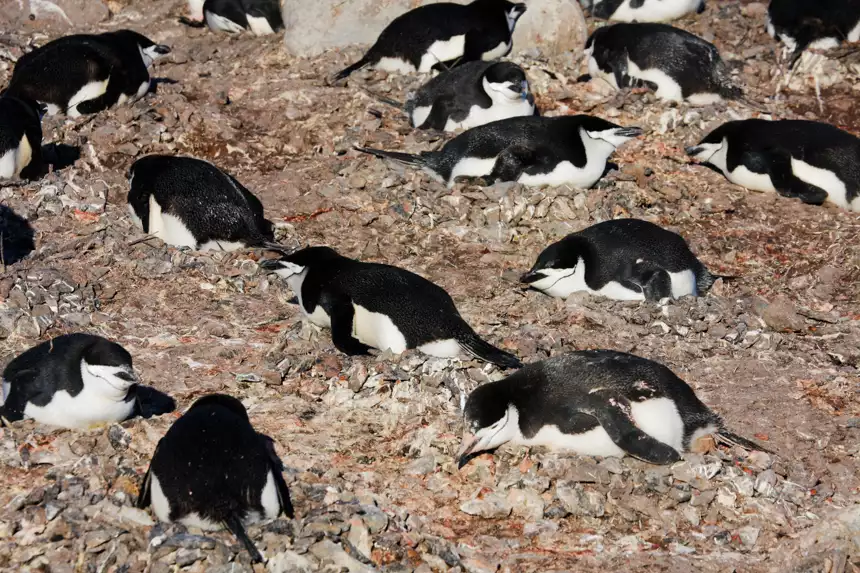
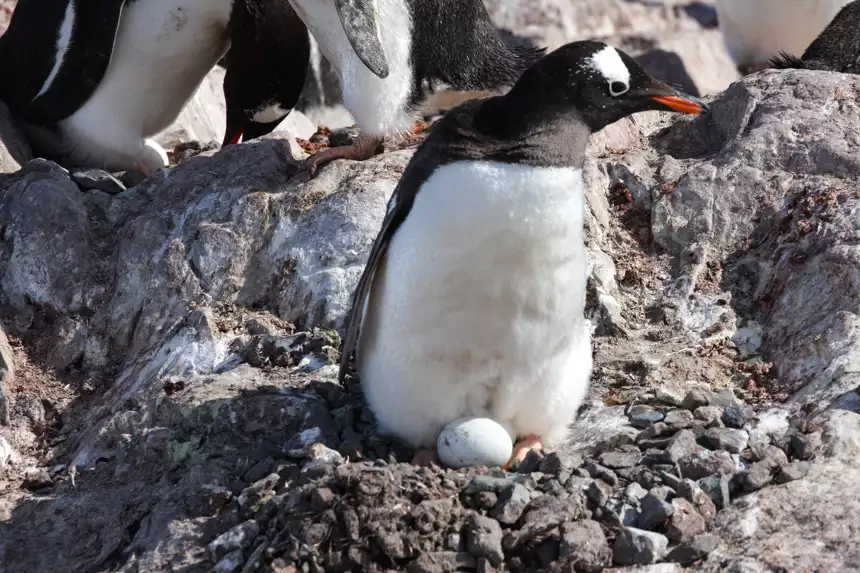
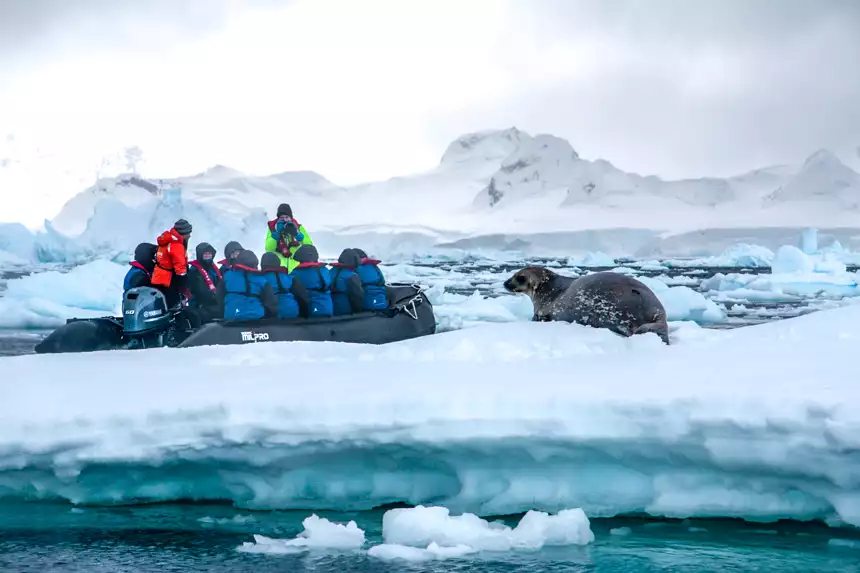
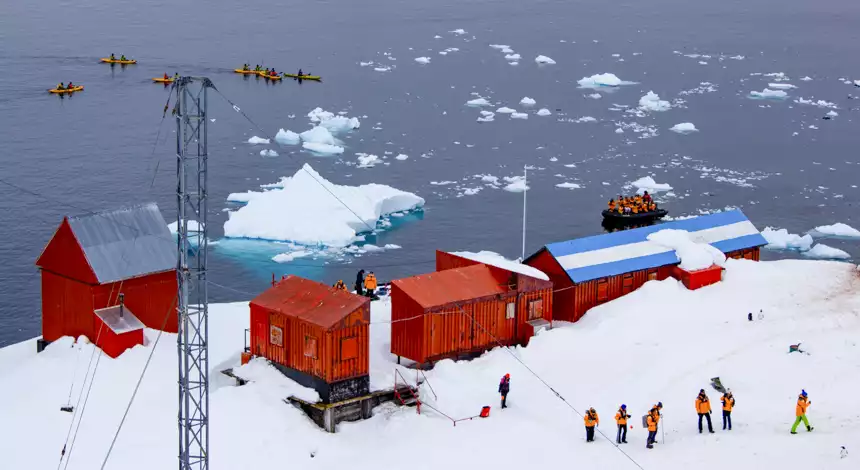
Antarctica Weather in December
- Average temperature in Antarctica in December: 29-34 degrees & 16.5 hours of daylight
- South Shetland Islands temperature in December: 23-27 degrees & 20 hours of daylight
- South Georgia Island temperature in December: 32-46 degrees & 17 hours of daylight
Benefits of Visiting Antarctica in December
- Good chance for calmer seas crossing the Drake Passage
- Warmest months and nicest weather of the Antarctica seasons begins
- Glaciers are actively calving as temperatures rise
- Research and station visits peak in Antarctica beginning in December
- Long days with midnight sun create more opportunities for exploration & wildlife viewing
- Whales are beginning to arrive in Antarctica
- Spring wildflowers bloom on South Georgia Island
- Historic whaling village of Grytviken & Shackleton grave accessible on South Georgia Island
Antarctica Wildlife in December
- Whales starting to arrive to Antarctica in December
- Leopard, Crabeater, Weddell & Elephant seal pups are commonly seen on ice floes
- Penguins, petrels and cormorants are laying eggs and sitting on their nests
- Penguin chicks begin to hatch in late December in Antarctica
- Penguin chicks begin to hatch in early December in the Falkland Islands.
- Fuzzy brown King penguin chicks are hatching on South Georgia Island
- Wandering albatross return to lay eggs on South Georgia Island
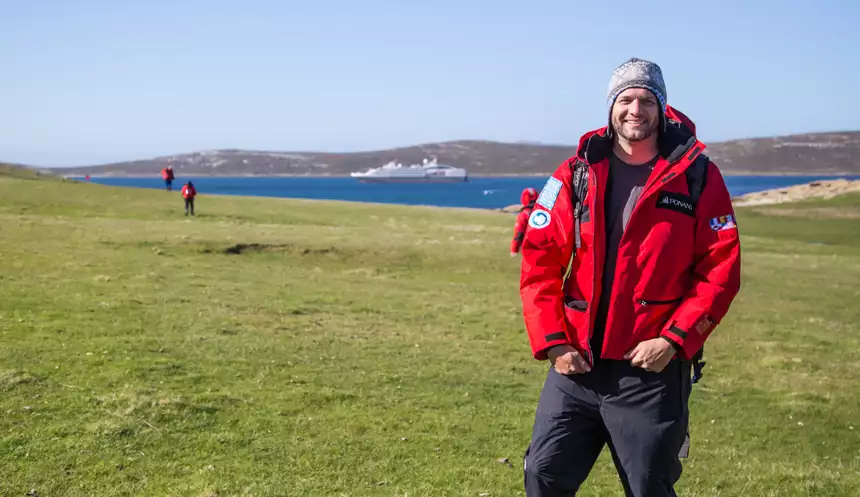
PERSONALIZED PLANNING
One-on-one service.
Over 20 years experience.
Antarctica in January
Being the height of the travel season with cruises in full swing, travelers often ask “What is the weather like in Antarctica in January.” The weather in Antarctica in January is excellent, with average temperatures reaching their highest of the year. Undoubtedly January is the warmest month in Antarctica. January is the best time to go to Antarctica because of calm weather, calm seas and abundant wildlife.
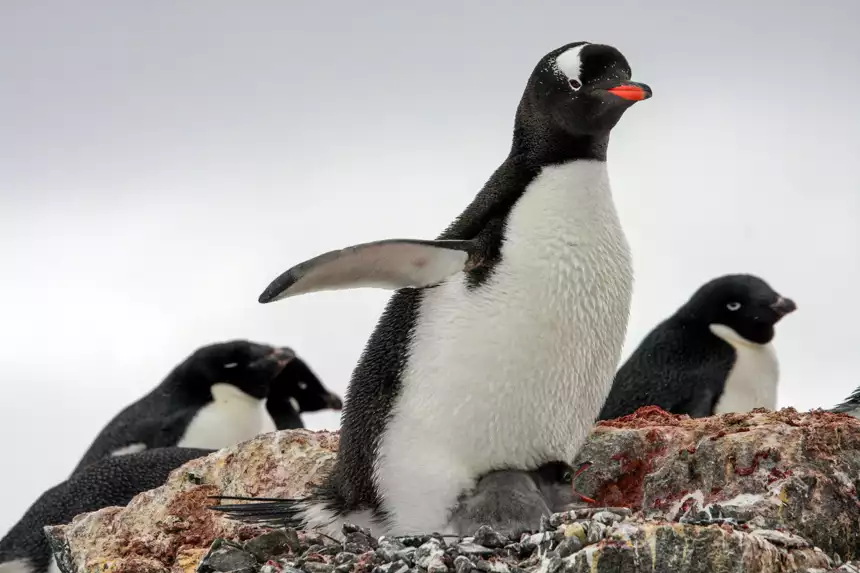
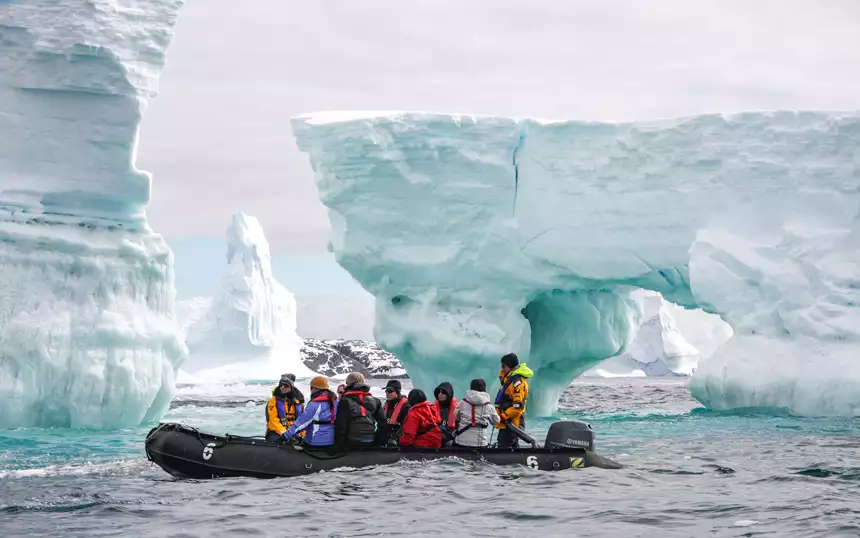
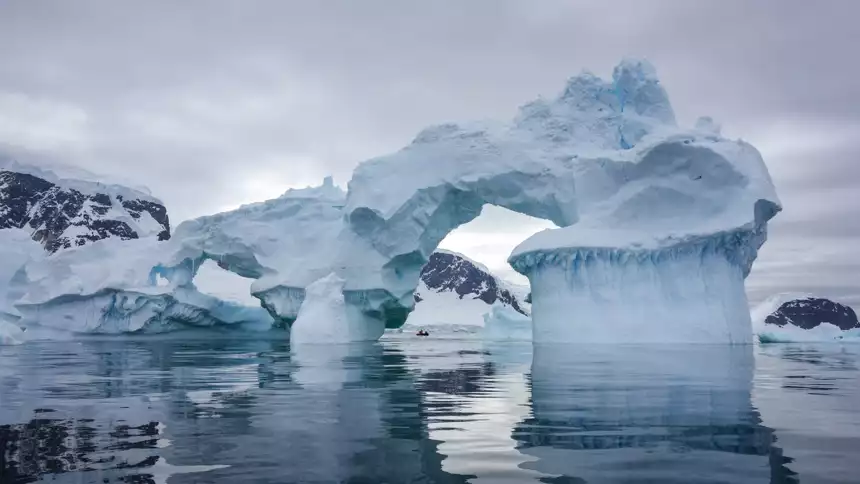
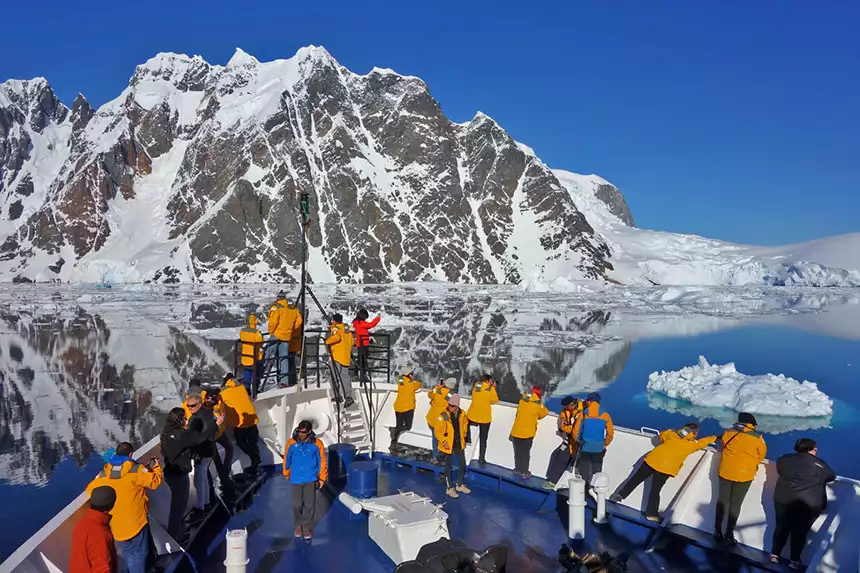
Weather in Antarctica in January
- Average temperature in Antarctica in January: 33-36 degrees & 16 hours of daylight
- South Shetland Islands temperature in January: 25-29 degrees & 19 hours of daylight
- South Georgia Island temperature in January: 32-46 degrees & 16.5 hours of daylight
Benefits of Visiting Antarctica in January
- January is the warmest month in Antarctica with average high of 36 degrees
- Zodiac cruises are intriguing with melting icebergs, shaped by the sun
- Sea ice opens allowing for visits to more landing sites and wildlife
- Certain itineraries start attempting to reach the Antarctic circle
- Historical huts of Shackleton and Scott in the Ross Sea are accessible
Antarctica Wildlife in January
- Hatching or newly hatched penguins are abundant
- Penguin feeding frenzies begin as parents bring their young food from the sea
- Baby Antarctic terns are hatching
- Baby seals are lounging about with their parents
- Whale sightings are increasing
- Population of King penguins on South Georgia Island is highest
Antarctica in February
February is the best time to see whales in Antarctica. If you like whale watching, this is your month. It’s the best time to visit Antarctica for predictable whale watching, penguin chick activity ashore, and the shorter days lend themselves to excellent sunrises and sunsets punctuated by those whale tails. The weather in Antarctica in February is begging to cool and days are getting shorter. Fall is fast approaching.

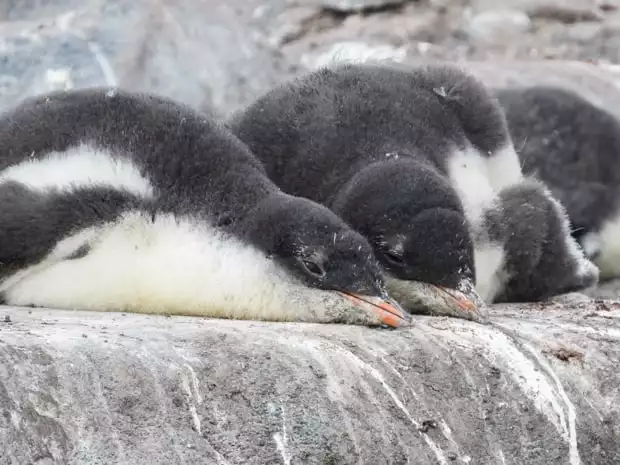

Weather in Antarctica in February
- Average temperature in Antarctica in February: 28-34 degrees & 14.5 hours of daylight
- South Shetland Islands temperature in February: 25-33 degrees & 16 hours of daylight
- South Georgia Island temperature in February: 35-48 degrees & 15 hours of daylight
Benefits of Visiting Antarctica in February
- Best time to view whales. Long days generate plankton blooms, a buffet for feeding whales
- This is the best time to visit Antarctica for orca, minke and humpback whale watching
- Receding ice opens up and allows for even more exploration
- Epic sunrises and sunsets as days get shorter
Antarctica Wildlife in February
- Molting penguin chicks are running about
- Adult penguins are busy swimming after krill to feed their chicks
- Playful fur seal and leopard seal pups are commonly seen
- Whales become predictable visiting feeding areas sometimes traveling in large pods
- Orca whales arrive to feed seal pups and penguin chicks learning to swim
- Abundant fur seal populations
- Elephant seals come ashore to molt
- King Penguin chicks on South Georgia Island are beginning to mold
Antarctica in March
March is the best month to go to Antarctica if you are seeking color! Algal blooms, night sky viewing, sunsets and possible sightings of aurora australis all make Antarctica in March a fascinating month. March is the best time of year for polar circle cruises to accomplish this bucket list goal. March is also a good time to find Antarctica cruise deals since the season is winding down and the weather is turning cooler. March in Antarctica is characterized by shorter days, colder weather and waterways virtually free of sea ice.
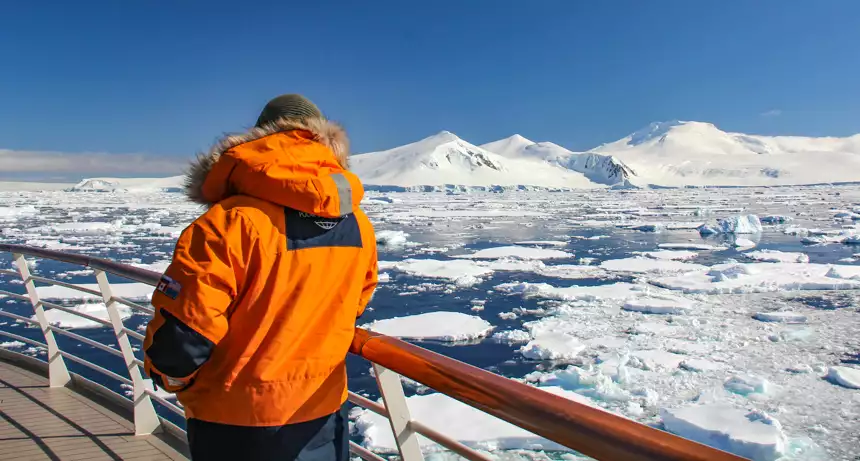
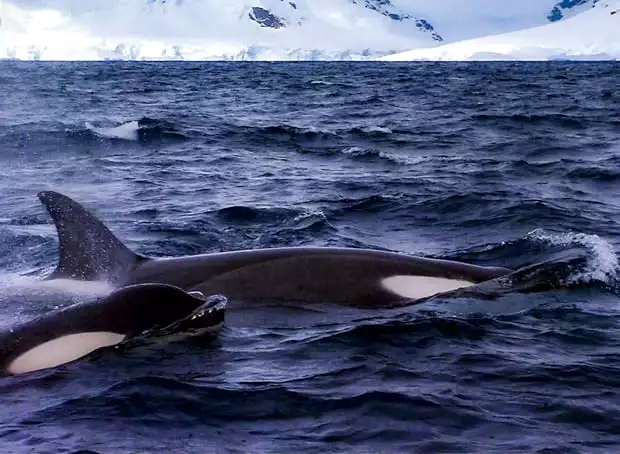
Antarctica Weather in March
- Average temperature in Antarctica in March: 26-32 degrees & 12.5 hours of daylight
- South Shetland Islands temperature in March: 22-30 degrees & 13 hours of daylight
- South Georgia Island temperature in March: 33-46 degrees & 13 hours of daylight
Benefits of Visiting Antarctica in March
- Great time to see whales in Antarctica
- Less sea ice means more opportunities to reach the polar circle
- Snow-free beaches allow for more landing sites and easy sightings of large penguin rookeries
- Best time to travel to Antarctica for night sky viewing, weather permitting
- Green and pink algae blooms show their colors on snow and ice cliffs
- Possible sightings of aurora australis, also known as southern lights, during dark nights
- Lower prices and more availability making this the best time to visit Antarctica for a deal
Antarctica Wildlife in March
- Adolescent penguins explore colonies, finish molting & grow adult feathers to begin swimming
- Some Adelie, chinstrap and gentoo rookeries are empty, as adults return to the sea to feed
- South Georgia Island’s king and macaroni penguin rookeries are highly populated
- Some birds, like Antarctic terns, start flying north
- Whale activity is high as they feed furiously before migrating north
Best Month to Cross the Drake Passage
Ocean conditions can undoubtedly affect your Antarctic plans. The infamous Drake Passage is the body of water between South America’s Cape Horn and the Antarctic Peninsula. Currents at this latitude meet no resistance from any landmass. Combined with high winds this can make for a rough crossing certain times of year.
We are often asked “What is the best month to cross the Drake Passage?” January is the best time to cross Drake Passage with the best chance for calm seas. During the height of summer winds may abate and seas may calm. See our post about how to prevent and treat seasickness on cruises. And consider yourself lucky if you experience calm seas any time you cross the Drake Passage.
Best Time to Cruise Antarctica
Most travelers will visit Antarctica by small ship. We could have called this guide the best time to cruise Antarctica, as all of the advice above applies to cruises. The best time to cruise Antarctica is December through February, which comprises the peak cruising season. We are often asked “When is the best month to cruise Antarctica?” If we had to pick one, the best month to visit Antarctica is January.
VIEW ALL ANTARCTICA CRUISES
See the full list of White Continent itineraries.
Best Time to See Penguins in Antarctica
Penguins can be found throughout the Antarctica travel season. The best time to see penguins in Antarctica is December through March. The best time to see penguin chicks in Antarctica is late January through the end of February. Viewing penguins is a highlight for most travelers visiting Antarctica.
Travelers can see up to eight species of penguin in Antarctica. Virtually all trips to the Antarctic Peninsula will see gentoo, adelie and chinstrap penguins. If you really want to see more species of penguins in Antarctica there are a few specialty cruises to consider.
Trips that visits South Georgia Island and the Falkland Islands will view vast colonies of king penguins and may also encounter rockhopper, megallanic, and macaroni penguins.
Emperor penguins are rare. But there are specialty emperor penguin cruises focused on finding and viewing the largest penguins species.
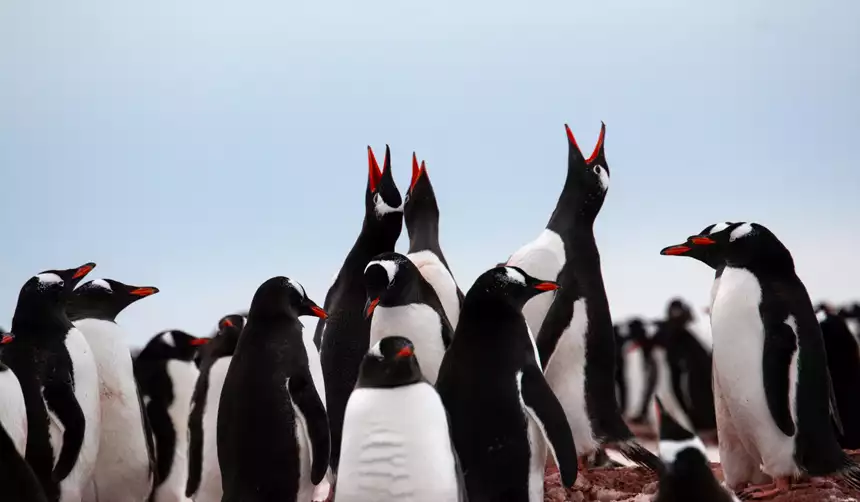
Best Time to See Whales in Antarctica
Whale watching is an exciting highlight of any visit to Antarctica. The best time to go whale watching and to see whales in Antarctica is February and March.
There are up to 8 whale species travelers might encounter in Antarctica. Humpback whales are the most commonly sighted whales, followed by smaller minke whales.
Migratory whales such as humpback whales, fin whales, blue whales and minke whales are begin arriving in Antarctica in November and December. Whales come to feed on abundant krill and small fish that explode as a result of long days and productive waters. Numbers increase and feeding pods form through January. By February and March feeding pods have formed making this the best time to see whales in Antarctica.
Orca whales don’t migrate and can be found in Antarctica year round. The best time to see Orca whales in Antarctica is in February and march when penguin chicks and seal pups are entering the water making an easy meal.
Whale watching is an incredible part of the Antarctic experience. Consider yourself lucky if you see whales on your trip.
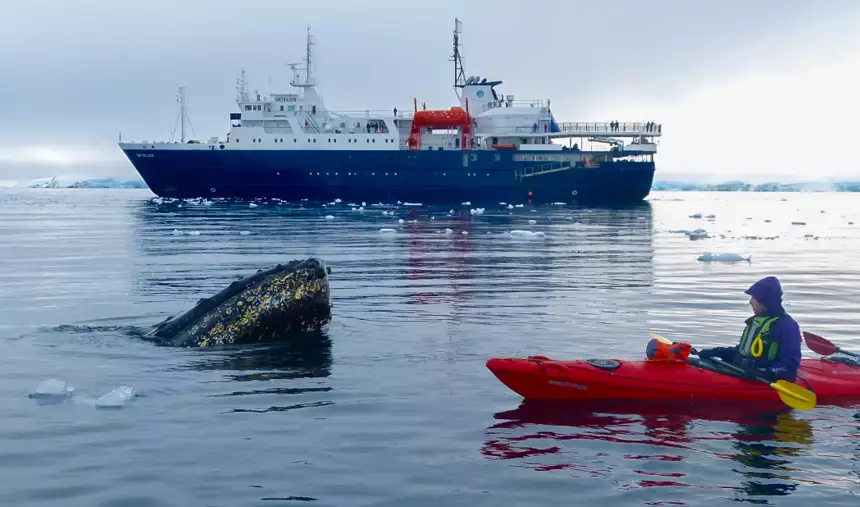
Latitude Matters When Choosing When to Visit Antarctica
Life at the south pole is affected greatly by latitude variances. Slight latitude shifts confer big changes in temperature, sunlight and seasonality. Combine this with the short Antarctic summer and you’ll see animals’ mating, laying and rearing cycles moving very fast!
The Antarctic Peninsula warms first at the northerly tip, and later in the south. This will affect penguins, wildlife and ice conditions. For instance, on our founder’s air cruise to Antarctica in December, he saw penguins mating and nest building; sitting on eggs; and newly hatched chicks all in different areas based on latitude north or south.
There are particularly significant differences for Falkland Islands and South Georgia cruise routes, as well as for routes that stretch into the eastern reaches of the Weddell Sea. Read more about the best time to visit for viewing South Georgia Island animals.
While this Antarctica by month guide is valuable resource for planning your own best time to visit Antarctica, note that wildlife and weather can never be fully predicted, especially in a land as dramatic as Antarctica.
Detailed Climate Tables
View our Antarctica climate page to see Antarctica average temperature by month and daylight hours in detailed locations like the Antarctic Peninsula, South Shetland Islands, South Georgia Island and Ushuaia. As most cruises focus on the Peninsula, here is our detailed table for that region:
Antarctic Peninsula Weather by Month
Antarctic Peninsula Average Temperature, Rainfall & Daylight
| Month | Jan | Feb | Mar | Apr | May | Jun | Jul | Aug | Sep | Oct | Nov | Dec |
|---|---|---|---|---|---|---|---|---|---|---|---|---|
| Avg. High (F) | 36 | 34 | 32 | 33 | 28 | 29 | 24 | 22 | 25 | 29 | 32 | 34 |
| Avg. Low (F) | 33 | 28 | 26 | 24 | 22 | 19 | 15 | 16 | 17 | 22 | 25 | 29 |
| Avg. Rain |
2.1 | 2.3 | 2.7 | 2.8 | 2.5 | 1.8 | 1.6 | 1.8 | 2.0 | 2.6 | 1.9 | 1.5 |
| Avg. Day |
16 | 14.5 | 12.5 | 10.5 | 9 | 8 | 8 | 10 | 12 | 14 | 15.5 | 16.5 |
So, What Is the Best Month to Go to Antarctica?
Considering everything stated above, the best month to go to Antarctica is January. There is a reason January is the peak Antarctica season. The wildlife is active, the ice is spectacular, and the weather is hard to beat.
But not everyone can or should schedule their trip during this time since each month has its benefits. You really can’t go wrong choosing any time in Antarctica’s six-month cruising season. If you plan your trip during the peak season of mid-December through mid-February, then be sure to book early as these are the dates that sell out first.
Need more information on when to travel to Antarctica? Our timeline above aims to be a detailed guide for you to determine your own individual best month to go to Antarctica. Our experts are here to assist with even more detail. Contact us to learn more about planning an Antarctica cruise and the best time to visit Antarctica for your travel needs. We are here to help with one-on-on advice and ensure you have a great trip any time of year.

MAKE IT HAPPEN
Full-service booking from
experts who’ve been there.
Keep researching your visit to Antarctica with our resources below. Or, simply have the latest about Antarctica delivered to your inbox by signing up for the AdventureSmith Explorations newsletter.
MORE ANTARCTICA RESOURCES:
Antarctica Travel Guide
Antarctica Cruises
Luxury Antarctica Cruises
Falkland Islands & South Georgia Cruises
Cruises with Flights to Antarctica
Antarctica Cruise Cost
How to Get to Antarctica
Things to Do in Antarctica
Places in Antarctica
Antarctica Ships
Best Antarctica Cruise Lines
Antarctica Cruise Deals
Antarctica Cruise Reviews
Have a question or looking for advice about the best time to visit Antarctica? Use the comments below and we’ll answer your question and make this guide even better.
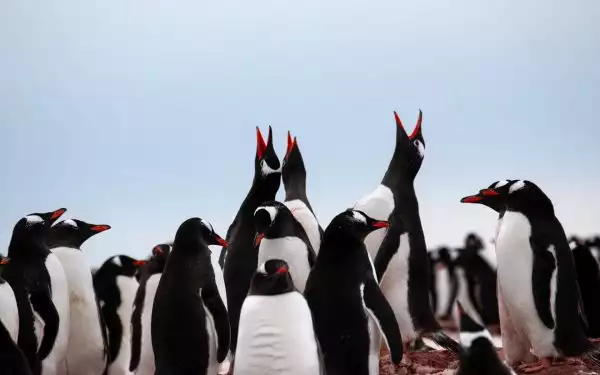
Comments will be moderated and will appear after they have been approved.
Hi, if I would like to kayak, what is the best month to visit Antarctica, and what are the ships or itineraries I should consider?
Hi Wai Yee,
Kayaking is available on most of our expeditions, at ANY time of the cruising season, but space can fill up fast for coveted spots. If you have your heart set on kayaking, it’s a good idea to book as soon as you can. Options range from short one-time paddles to full programs that let you kayak every day. We will have an Adventure Specialist be in touch to further hone in the best time to kayak in Antarctica & the best trips for doing so based on what’s available now or next season. Generalizations for timing kayaking would be to expect more ice and pristine landscapes if you kayak in early season (Nov-Dec) and to potentially get closer encounters with whales during kayak excursions later in the season (Feb-March).
Hey! How is end of March for a visit? 🙂
Hey Ashwini!
March in Antarctica has its benefits. Whales are plentiful (humpbacks in peak numbers), sunsets/rises are long and vivid, and less snow allows for more landing sites and access to areas further south. By late March the cruise season is wrapping up as the temperatures drop. You can often find more Antarctica cruise deals and enjoy the feeling of having Antarctica to yourself. Here’s a list of Antarctica trips in March; for detailed availability please contact an Adventure Specialist.
Best months to visit? We want to see the baby animals, plus we are going to tie it in with a trip to Machu Picchu.
Sue,
Wow that sounds like quite a trip! These are two of our most popular destinations. Baby penguins are usually most prevalent in January while seal pups are most commonly seen in February, but it always depends where you go as timing can change by latitude. Talking to an Adventure Specialist can help you find the best timing and trip for you and will be reaching out to you shortly.